Badger field signs
Learn to recognise badger field signs, and enjoy a sense of close proximity to badgers without ever seeing the animals.
Here are some examples of what to look out for:
Badger setts
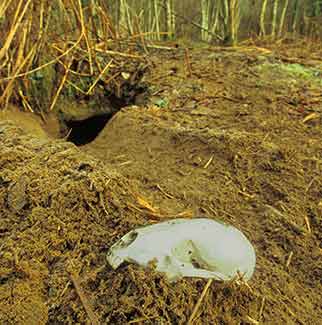
Badger setts often have a large number of entrances - sometimes in excess of 40. To assist drainage, Badger setts are often on sloping ground, and in the New Forest, many are near grassland or cultivated land which provides a better prospect of food than the relatively infertile New Forest soils.
Badger sett entrances are noticeably bigger than rabbit burrow entrances. Spoil heaps, too, are often large, with furrows down the centre that mark the route used during excavation and subsequent, repeated Badger passage.
Badger-created undulations are often visible on both sloping and otherwise flat ground – these are the sites of old spoil heaps.
Look out, too, on the spoil heaps for bones excavated from deep underground where past Badger generations have died.
Badger latrines
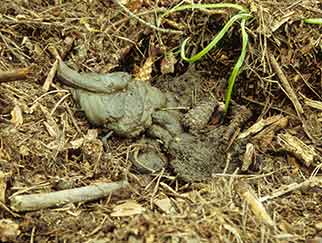
Badgers are tidy animals that use shallow pits, latrines, sometimes repeatedly, in which to deposit their often squishy droppings. These latrines are often located near the sett, and also occur around territory boundaries where they give notice of occupation to potential badger intruders.
Content and appearance of badger droppings reflect the diet of these animals- they are omnivorous feeders that will eat just about anything edible. Earthworms are perhaps their favourite food, but berries, grasses, invertebrates and, when available, birds’ eggs will all be taken with enthusiasm.
Two examples are illustrated here. The first is fairly typical, whilst the second, containing large numbers of beetle wing cases, is much less so.
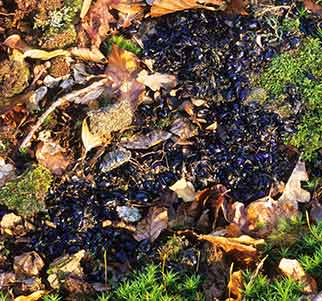
(Fox droppings, in contrast, are often fairly firm, relatively slender, quite long, cylindrical in shape and significantly tapered at the ends, although this is not always the case as, after a period of time, the weather might influence the appearance of the droppings, whilst the fox'es recent feeding habits will also be reflected in the characteristics of its faeces).
Badger paw prints
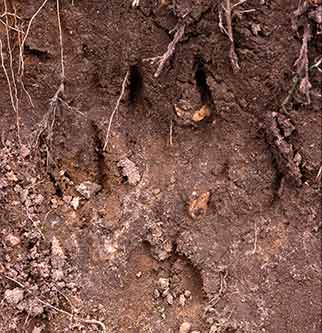
Badgers are stocky animals that leave relatively large footprints. The outline of all five toes is often visible, whilst strong, lengthy claws usually leave deep gouge marks in the mud.
Look out also for Badger claw marks on tree trunks and stumps around the sett – Badgers habitually leave deep scratches in fallen and standing timber.
Badger passage places under fences
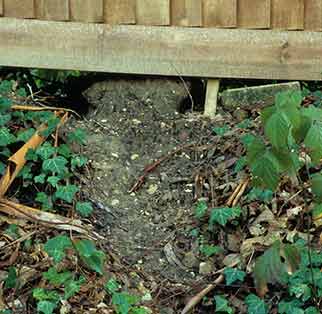
Badgers are incredibly strong, habitual diggers. Much to the annoyance of owners, fences are regularly dug through or under. On regularly used routes, blocking the way – as has been attempted here with the right-hand gap – is often to no avail as the Badger simply digs and damages again.
Hedgehog remains
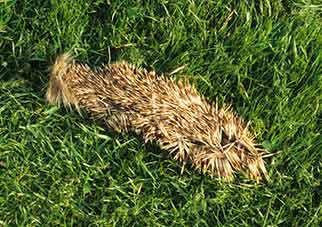
In Britain, badgers are one of the hedgehog’s few, regular natural predators. Look out for hedgehog skins and spines, the remains of a tasty badger meal.
Honeycombs
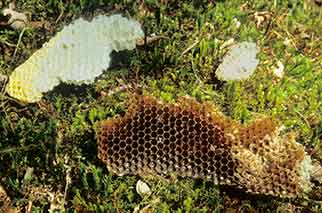
Badgers regularly attack bees’ nests – the Badgers eat the larvae, pupae and stored honey, and leave damaged honeycombs as evidence of their work.
Further information and a variety of fascinating badger videos
References:
The Natural History of Badgers, Ernest Neal
Badgers: Ernest Neal and Chris Cheeseman
Darkness Is Light Enough: Chris Ferris
Out of the Darkness: Chris Ferris
Eileen Soper's Badgers
Mammals of Britain and Europe: David Macdonald and Priscilla Barrett
More links
Other related links
Search this site

Sadly, 58 animals were killed - 35 ponies, 13 cows, 8 donkeys and 2 sheep, whilst a further 32 were injured - 3 pigs, 9 donkeys, 11 cows and 9 ponies.
(Forty-three accidents occurred in daylight, 15 at twilight and 101 in the dark. Twenty-seven accidents were not reported by the driver involved).
Here's just one horrific example - Three donkeys killed in collision with van at notorious New Forest blackspot (Advertiser and Times)
Sika deer continue to engage in rutting behaviour, and will do so until December.
Pigs seek out the remains of the acorn crop.
Beech leaves are transformed into a magnificent mosaic of glorious reds and golds. Other deciduous trees, too, take on an autumnal cloak before their leaves fall.
Dragonflies can occasionally be seen on the wing on bright days early in the month.
December
Foxglove leaves survive the winter at ground level, and offer the prospect of colourful summer blooms to come.
Redwings and fieldfares, autumn and winter visitors, gorge on haws and holly berries.
Great grey shrikes and hen harriers hunt over the heaths and other open spaces.
Honeysuckle by the end of the month often shows welcome signs of new growth.

